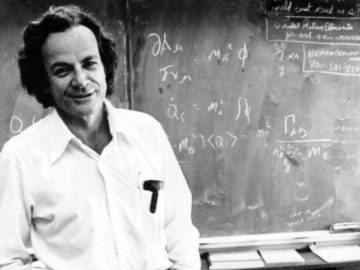Alan Lightman in Nautilus:
 One day at lunch in the Caltech cafeteria, I was with two graduate students, Bill Press and Saul Teukolsky, and Feynman. Bill and Saul were talking about a calculation they had just done. It was a theoretical calculation, purely mathematical, where they looked at what happens if you shine light on a rotating black hole. If you shine it at the right angle, the light will bounce off the black hole with more energy than it came in with. The classical analogue is a spinning top. If you throw a marble at the top at the right angle, the marble will bounce off the top with more velocity than it came in with. The top slows down and the energy, the increased energy of the marble, comes from the spin of the top. As Bill and Saul were talking, Feynman was listening.
One day at lunch in the Caltech cafeteria, I was with two graduate students, Bill Press and Saul Teukolsky, and Feynman. Bill and Saul were talking about a calculation they had just done. It was a theoretical calculation, purely mathematical, where they looked at what happens if you shine light on a rotating black hole. If you shine it at the right angle, the light will bounce off the black hole with more energy than it came in with. The classical analogue is a spinning top. If you throw a marble at the top at the right angle, the marble will bounce off the top with more velocity than it came in with. The top slows down and the energy, the increased energy of the marble, comes from the spin of the top. As Bill and Saul were talking, Feynman was listening.
We got up from the table and began walking back through the campus. Feynman said, “You know that process you’ve described? It sounds very much like stimulated emission.” That’s a quantum process in atomic physics where you have an electron orbiting an atom, and a light particle, a photon, comes in. The two particles are emitted and the electron goes to a lower energy state, so the light is amplified by the electron. The electron decreases energy and gives up that extra energy to sending out two photons. Feynman said, “What you’ve just described sounds like stimulated emission. According to Einstein, there’s a well-known relationship between stimulated emission and spontaneous emission.”
Spontaneous emission is when you have an electron orbiting an atom and it just emits a photon all by itself, without any light coming in, and goes to a lower energy state. Einstein had worked out this relationship between stimulated and spontaneous emission. Whenever you have one, you have the other, at the atomic level. That’s well known to graduate students of physics. Feynman said that what Bill and Saul were describing sounded like simulated emission, and so there should be a spontaneous emission process analogous to it.
We’d been wandering through the campus. We ended up in my office, a tiny little room, Bill, Saul, me, and Feynman. Feynman went to the blackboard and began working out the equations for spontaneous emission from black holes. Up to this point in history, it had been thought that all black holes were completely black, that a black hole could never emit on its own any kind of energy.
More here.
